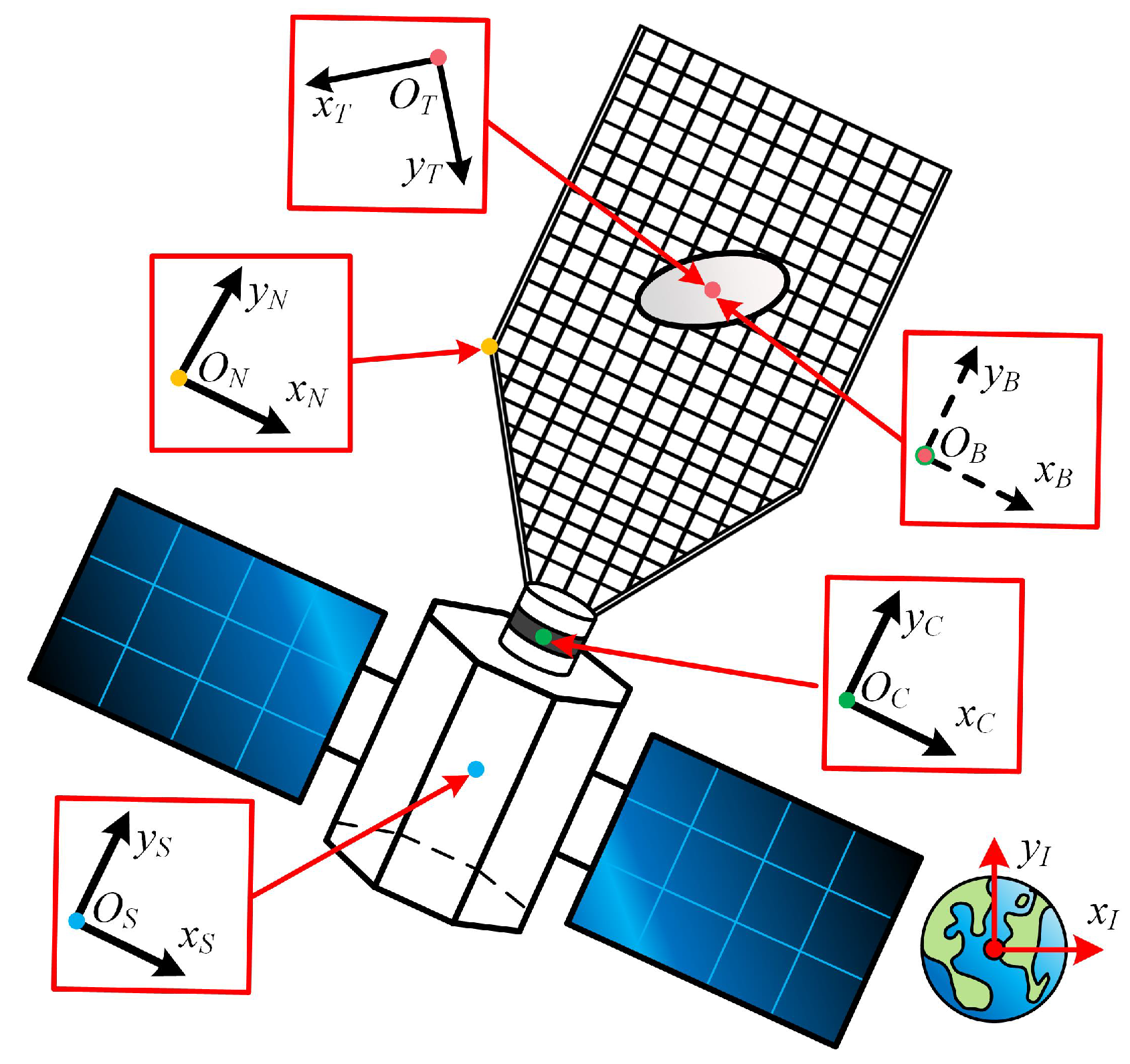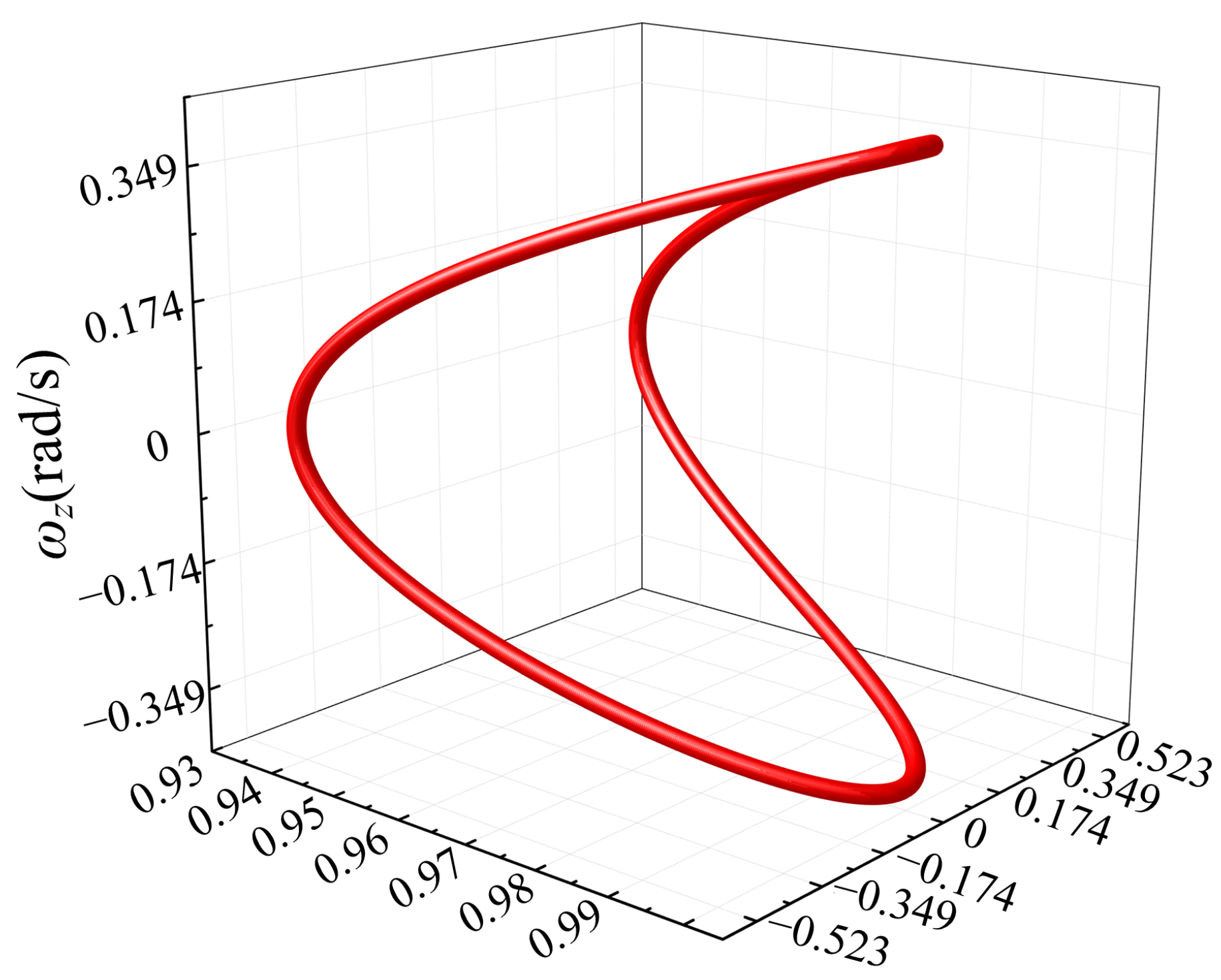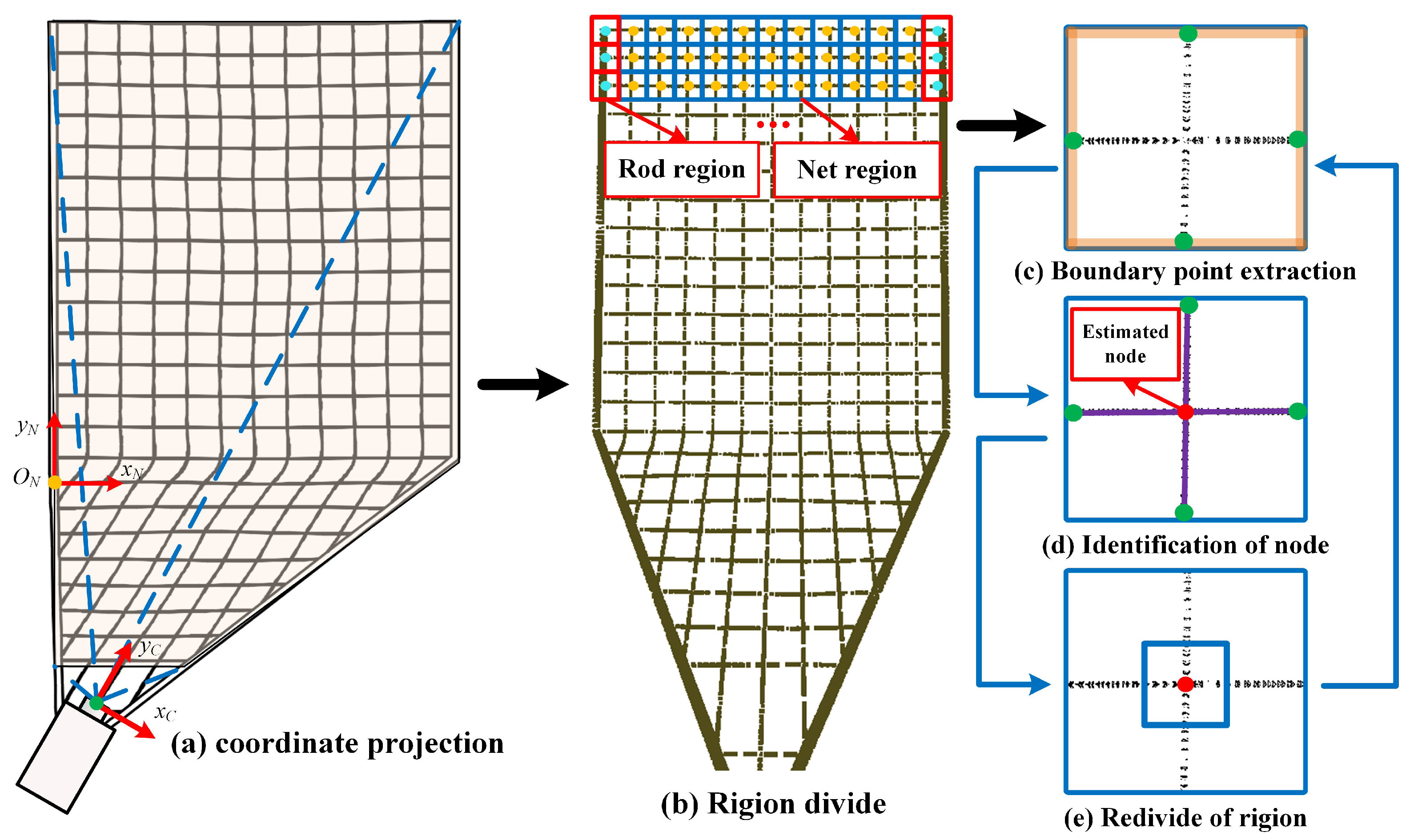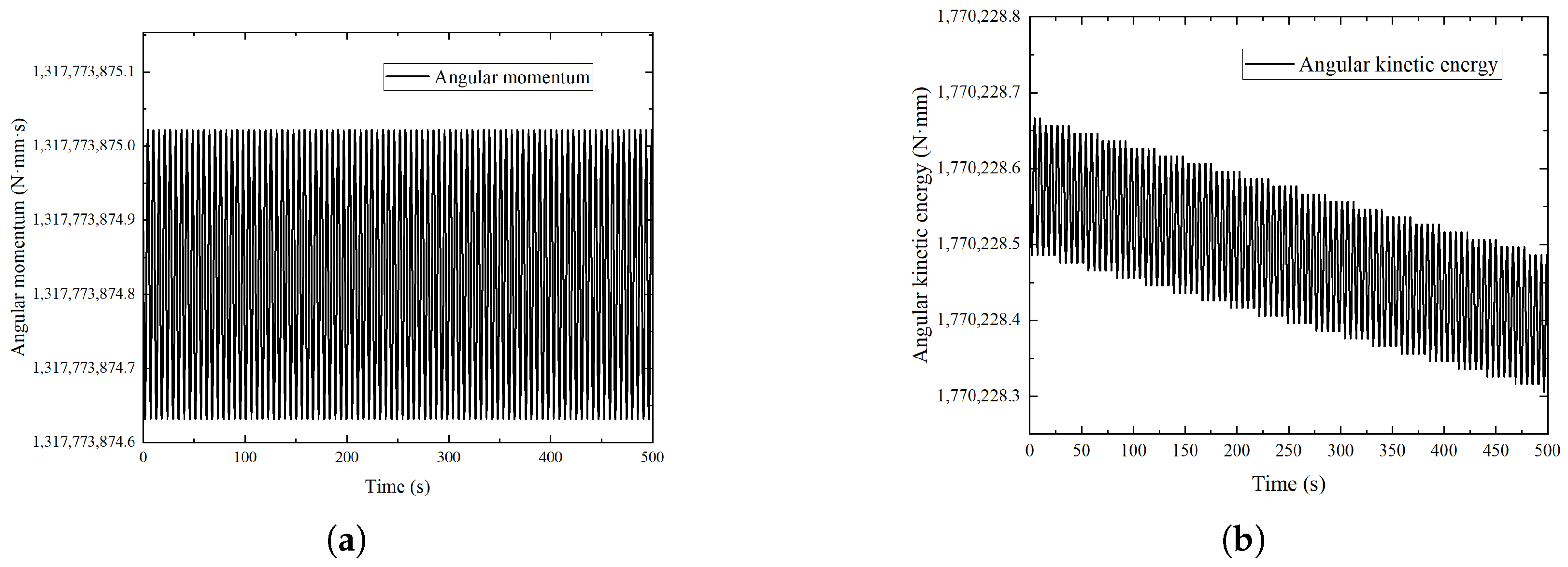In this section, the identification method based on rope net flexible collision and vision will be discussed. It is divided into two steps: first, before the collision, the LiDAR is used to scan point clouds of the debris, and then the rotation and translation motion data of the debris are calculated. Furthermore, based on motion data and the debris dynamics model, optimization calculations are performed to obtain the center of mass of the debris with the normalized inertia tensor, normalized angular momentum. It should be noted that the literature [
11] shows that there is always an unmeasurable parameter when identifying the 6-DOF
using the non-contact method, with the result that only normalized inertia tensor
and normalized angular momentum
can be solved without contact with space debris. After the normalized parameter identification, collisions of unilateral capture nets with debris are carried out and parameter true value identification is performed. Due to the time-varying contact area of rope net, collision force and debris movement state during collision, there is an excessive number of parameters to identify, which makes it difficult to identify them efficiently. And it is difficult to collect point clouds by LiDAR because of the occlusion of the area. Therefore, the collision process is not considered in the paper, only the motion state of debris, satellite and rope net prior to and after the collision is considered. As the process of identification–collision–identification takes little time, the influence of the low perturbing force in space can be ignored; the debris–satellite–rope net system maintains the conservation of angular momentum. Therefore, the changes in subsystem angular momentum parameters before and after collision can be used to identify the true values of dynamic parameters efficiently, and to finally solve all the dynamic parameters needed for the debris detumbling and capture process. The two-step identification method of full debris dynamic parameters is described below.
3.1. Identification of the Center of Mass and Normalized Dynamic Parameters Based on Vision
In order to reduce the influence of extreme optical environment in space, the point cloud data of the large space debris is obtained by LiDAR. The D2D-NDT algorithm is used to solve the point cloud registration to improve the calculation efficiency of debris pose [
19]. Let the source point cloud at time
i be
, and the target point cloud at time
be
, then the calculation for the point cloud registration is as follows:
where
are the transformation parameters to be optimized,
is the transformed mean vector distance,
is the mean of each Gaussian component,
is rotation matrix and
is translation vector.
is the covariance of each Gaussian component, where
. And
and
are the number of Gaussian components in the NDT model at time
i and time
respectively;
and
are regularization factors. After the point cloud registration, the angular velocity
, linear velocity
, angular acceleration
and linear acceleration
of the debris can be obtained from the central difference of the transformation matrix at time
,
i and
:
where the value of
can be the rotation vector
or the translation vector
, and
is the time interval. The angle
can be obtained from Equation (
2) and the normalization condition of the vector
. Expanding the right-hand side of Equation (
2) yields:
The normalization condition of the unit vector
can be expressed as follows:
Then, from Equations (
11) and (
12), the expression for angle
can be derived:
where
denotes the trace of the matrix
. The motion of the debris can be divided into rotation motion around the center of mass and translation motion of the center of mass, and the motion of characteristic point
can be described as:
where
is the linear velocity of the feature point
m, which can be obtained by the position difference of the feature point at two moments.
is the distance from the feature point to the center of mass.
is the translation speed of the center of mass (based on the motion characteristics of debris). Then, the distance
from the feature point to the mass center at time
i can be obtained from (
14). Then, using the locations of multiple feature points measured at moment
i as the center of the sphere and the distance
as the radius, the spheres can be created. It is known that the center of mass of the debris should be located at the intersection of spheres under the condition of accurate measurement. However, due to the measurement error of LiDAR, the spherical surface essentially cannot intersect at one point. Therefore, the center of mass should be located at the point with the shortest distance from every spherical surface in space and then it can be transformed into an unconstrained optimization problem, and then the objective function can be established:
where
is location of the center of mass. Then, the more accurate centroid position at time
i can be obtained by using the positions of multiple feature point pairs. Then, a debris-fixed coordinate system
B can be established based on the centroid position
calculated at the initial sampling time and its origin is located at the mass center of debris, and the directions of each axis are the same as those of
C. According to the definition, the initial rotation matrix
from the coordinate
B to the coordinate
C is the identity matrix, and the motion parameters can be projected into the
B coordinate system through this matrix in the initial timepoint. At the same time, the angular velocity and angular acceleration vectors at each timepoint can be easily transformed into the debris-fixed coordinate system
B through the rotation matrix
and the position of mass center
which is calculated at each timepoint:
where
or
. Then, the projection of angular velocity
and angular acceleration of space debris
in the debris-fixed coordinate system
B can be obtained. Using the angular velocity and angular acceleration at multiple times, the inertia tensor matrix is optimized based on the torque-free Euler–Poinsot model:
The basic form of inertia tensor contains six independent parameters, including the three moments of inertia relative to three axes and the three products of inertia, which represents the mass distribution of debris in the coordinate system. However, due to the incomplete observation of the non-contact method, it can only measure the normalized five parameters. When each axis in the coordinate system points to the principal axis of inertia, that is, in the
T coordinate system, the normalized inertia tensor matrix becomes a diagonal matrix containing only two normalized principal moments of inertia, which can be estimated by the dyadic coordinate transformation:
where
(
); at the same time, the transformation matrix
between coordinate system
T and the coordinate system
M can be estimated from the above transformation (because the coordinate system
B and the coordinate system
T are debris-fixed coordinate systems, the matrix is constant). Because
is known in the process of estimating the center of mass,
can finally be known. Then, the angular velocity
and the angular acceleration vector
in the principal axis coordinate system
T at each moment can be finally known. Therefore, the normalized parameters can be estimated through the conservation of the normalized kinetic energy and the normalized momentum:
where
is the normalized angular kinetic energy and
is the normalized angular momentum, which is known to be constant by definition. Then, the values of these two normalized parameters can be optimized by using the angular velocity data at multiple timepoints. After the estimation of the value of the principal moment of inertia by the collision, the angular kinetic energy and angular momentum true values can be obtained by using the calculation results of Formulas (
20) and (
21). However, the momentum is a vector, and the modulus only cannot be applied to the detumbling operation. It is necessary to obtain the identification method for the angular momentum direction. According to Poinsot’s geometric explanation of Euler–Poinsot motion, the angular velocity projection in LiDAR coordinate system
I should be on the same plane and the direction of the angular momentum is in the vertical direction from the center of mass to the plane. Therefore, the normalized angular momentum of space debris can be obtained by solving the normal vector of the plane:
where
are unit vectors indicating the direction of the angular momentum vector. And from the star cameras and satellite orbit data, the rotation matrix from the satellite coordinate
C to the inertial coordinate
I can be obtained more easily, i.e., the angular velocity data under
C can be used to solve Equation (
22). From the above optimization function
to
, the real-time position of the center of mass, normalized inertia tensor, normalized kinetic energy, normalized angular momentum and the direction of angular momentum of the debris can be estimated based on the L-M algorithm. In the following, the true value of the space debris dynamic parameters will be identified based on the comparison of the parameters before and after the collision.
3.2. Estimation of the True Value of Full Dynamic Parameters Based on Rope Net Flexible Collision and Vision
Spacecraft, rope net and space debris are regarded as the whole system in this paper, which is not disturbed by external forces before, during or after collision (short identification time, ignoring the effect of spatial perturbation). And the system maintains the conservation of angular momentum and linear momentum. Furthermore, the following two equations can be established from the conservation of momentum before and after the collision:
where
is the linear momentum,
is the angular momentum, the lower corner marks
,
and
denote the relevant parameters of spacecraft, debris and capture net, respectively, and the superscripts (0) and (1) denote the parameters before collision and after collision, respectively. If the above formula is projected into the coordinate system
C, the linear momentum and angular momentum of the debris before and after the collision can be measured by the LiDAR, and the satellite-related motion parameters can be obtained by the inertial sensor carried by the satellite; only
,
,
and
in the above formula are unknown, and only one parameter of the inertia tensor
is unknown after the solving of the previous Formula (
18). In order to estimate the inertial parameters of the debris by Equations (
23) and (
24), it is necessary to estimate the momentum parameters
and
.
Because the flexible deformation process of the rope net is complicated, it is difficult to obtain the analytical solution. Therefore, most of the existing dynamic calculation methods use beam elements, solid elements and other models to discretize its structure in space, and use finite-element method for iterative calculation to obtain more accurate dynamic characteristics of the rope net. However, the combination of discrete finite element method and existing identification method of dynamic parameter is difficult, and it takes a long time, especially for the rope net of several meters in this paper. The number of elements can reach tens of thousands and the calculation time is extremely long; it cannot be applied to the process of detumbling and capture of space debris with high identification efficiency demand. Therefore, this paper simplifies its calculation in order to improve the efficiency of identification. Because the collision process is instantaneous, the friction force on the rope net is limited and the rope net material has a certain stiffness; its angular momentum is limited. Thus, the angular momentum of the rope net is ignored in the calculation of Equation (
24) (but the influence of angular momentum brought by the overall movement of the satellite needs to be considered). However, the rod can ignore its own deformation because of its high rigidity. Therefore, the whole movement of the net can be discretized to the nodes of the rope. The location of the node can be obtained by LiDAR, the velocity characteristics of the node are calculated by Equation (
9), and the mass of the rope network is uniformly discretized to the node. The linear momentum of the whole rope net can be estimated by the nodes’ mass and position, and the true values of the dynamic parameters can finally be obtained through Equations (
23) and (
24).
As can be observed from the analysis above, the key challenge of the current calculation is to estimate the nodes’ location using the collected rope points cloud. In this paper, a fast search method for the node position is proposed, which is divided into five steps:
- (1)
Point cloud projection: Since it is assumed that the rod of the rope net is rigid and does not deform, the transformation relationship between the LiDAR coordinate system C and the rope net two-dimensional coordinate system
N is known, and the projection coordinates of the node point cloud in
N can be obtained:
- (2)
Area division: The fixed point of the rope net on the rod is the starting and ending point of the segmentation, the node of the rope net before deformation is the center, the mesh side length is the division side length, and the area division is performed.
- (3)
Boundary point determination: In order to improve the speed of identifying the position of the nodes, this paper does not use the commonly used edge extraction algorithm and adopts a cyclic identification method of boundary point determination–intersection point identification of boundary points–regional redividing. For the determination of boundary points, in order to improve the search efficiency, a boundary point search method with “
” strategy is used, because the random error
of ranging is known when the LiDAR is calibrated on the ground and then the point closest to the boundary can be found in the
area inside the boundary. Then, the point cloud can be approximately regarded as being located on the same straight line through the
region and a straight line can be fitted:
The approximate boundary intersection point is found by solving the intersection point between the fitted straight line and the boundary.
- (4)
Identification of “node”: Use straight lines to connect the left and right boundary intersection points, and the upper and lower boundary intersection points, and find out the intersection point of the two lines. The coordinates of the intersection points are the once estimated coordinates of the nodes.
- (5)
Area redividing: taking the obtained estimated node as the center, taking 1/8 of the existing grid length as the side length, redivide the area. Repeat steps 2, 3 and 4, and finally get more accurate coordinates of the rope net node. Because the length of a single rope net mesh is about 0.5 m, the diameter of the rope net is 0.02 m, the rope net is relatively rigid, and there is the stretching effect of the rod; thus, the rope net will not be deformed greatly after the collision. Therefore, it only needs to be repeated three times to accurately identify the node position of the rope net and the relevant proof will be given in the subsequent simulation. The identification process of rope net node is shown as
Figure 4.
Then, a more accurate position of the rope net node can be obtained through the above steps. By replacing the position data of rope network nodes at multiple moments into Equations (
22) and (
23) for optimization calculation, the debris mass
and the inertia tensor unknown
C can be obtained:
where
is the transformation matrix between the inertial coordinate system
I and the LiDAR coordinate system
C, which can be obtained by multiplying
and
, and
can be obtained according to the measurement data of the star camera carried by the satellite. Then, the calculated debris mass
is substituted into (
23) to obtain the true value of the linear moment of the debris, and the obtained principal moment of inertia C is substituted into Equations (
20) and (
21) to obtain the module of the angular kinetic energy and the angular momentum, which are combined with Equation (
22) to finally obtain the true value of the angular momentum vector of the system. Through Equations (
1)–(
32), the true quantities of the full dynamic parameters of debris can be obtained, and the accurate data reference can be provided for subsequent detumbling and capture operations.






















